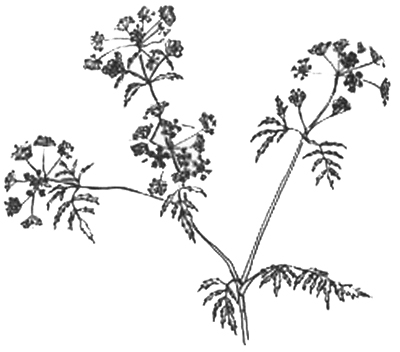 Much as I love to grow rosy-cheeked apples and long stripes of pale green butter lettuce, I equally welcome the presence of poisonous weeds and flowers in the garden. No paradise is complete without the murmur of these dark sorcerers from beyond the fringe: snakeroot and henbane, monkshood and deadly nightshade.
Much as I love to grow rosy-cheeked apples and long stripes of pale green butter lettuce, I equally welcome the presence of poisonous weeds and flowers in the garden. No paradise is complete without the murmur of these dark sorcerers from beyond the fringe: snakeroot and henbane, monkshood and deadly nightshade.
Chief among the poisonous plants I respect is Conium maculatum, or poison hemlock, also known as the executioner of kings and philosophers, or “Socrates’ friend,” for the swift and fatal hemlock dose the Greek philosopher was condemned to drink by his political enemies around 400 B.C.E.
Poison hemlock figured prominently in Anglo-Saxon medicine and is mentioned in the old herbals from as early as the tenth century, when minute doses of this plant were administered as a mild narcotic sedative in cases of nervous excitability, cramping, and epilepsy. Mixed with fennel seed and betony, hemlock was used for the bite of a mad dog, and, taken as an inhalation, it relieved the wrack of bronchitis, asthma, and whooping cough.
A vigorous, deep-rooted, and biennial member of the umbellifer clan, poison hemlock is a tall, multi-branching plant with finely cut foliage topped with umbels of small white flowers. When these flowers ripen their seed, the hemlock harvest is heavy: seed rains down in thick torrents, flooding the doors of the garden and drowning out less vigorous weeds.
The hollow, smooth stems of the hemlock plant are tarnished with sanguine flecks, often called “the blood of Socrates.” According to an Old English legend, these vivid stains also represent the brand that marked Cain’s brow after he murdered his brother.
The generic name for hemlock, Conium, derives from the Greek word konas, meaning “to spin or whirl about,” since when ingested in full dose the hemlock plant induces severe vertigo before death. I can attest to the dizziness caused by the poison hemlock because whenever I work with the plant for too long—grubbing its roots out of cultivated garden beds where it loves to grow—I feel nauseated and spun around by the rat-urine stench of raw conium juice.
I have an acquaintance who once mistakenly ingested poison hemlock. Lost in the woods for two days and weak with hunger, she came upon a stand of hemlock and pulled some tender shoots, since their tops so resembled their distant cousin, the carrot. The roots of the hemlock were albino white and limp, suffused with bitter poison. The famished woman ate them, sensing immediately a cold numbness that spread from her feet upward through her legs and into her lower groin. “If this poison reaches my heart, I’m gone,” she remembers thinking as the hemlock first seized her stomach, then reversed its flow. She retched and fainted, and was discovered a day or so later by a frantic search party.
I live in uneasy détente with poison hemlock, permitting it passage outside the garden gate where it grows rank on abandoned ground. There, the muscular taproots of hemlock split open seized earth, leaving behind a deeply stirred soil, strangely fertile, and alive with the musty scent of forgotten woods.
Sometimes when the summer perfume of zephyr lilies and clove-scented stock makes me swoon with its cloying sweetness, I stand downwind of poison hemlock and suck in one long draught of its acrid stench. Hemlock settles me, whispering that mysterious homeopathic truth that poison in proper dosage is medicine, and that the wounder also heals.
Outside the garden window this morning, our small stone figure of Shakyamuni Buddha rests in the summer heat under a wide-limbed elderberry tree. Behind the Buddha, reminding me that no garden is safe, grows a single plant of poison hemlock, Socrates’ friend, deepening the shade. ▼
Thank you for subscribing to Tricycle! As a nonprofit, we depend on readers like you to keep Buddhist teachings and practices widely available.